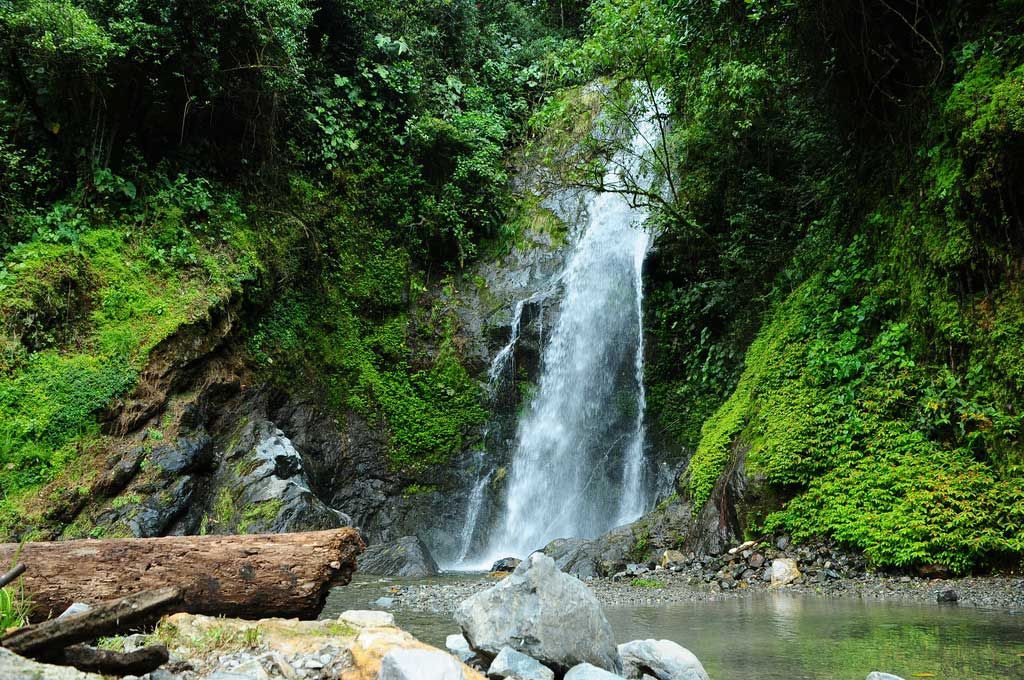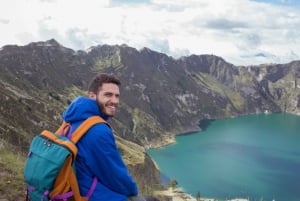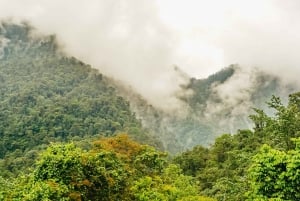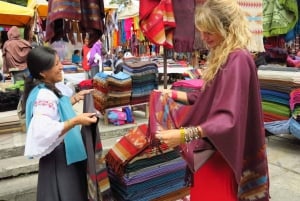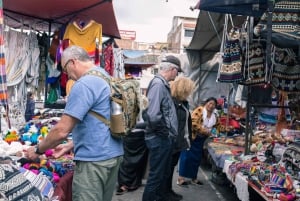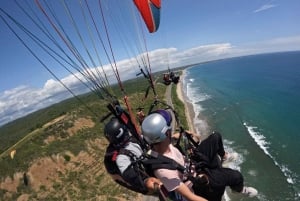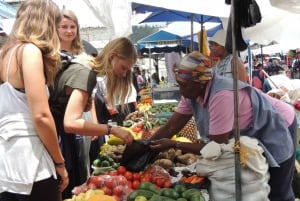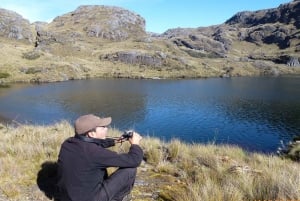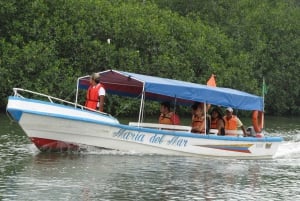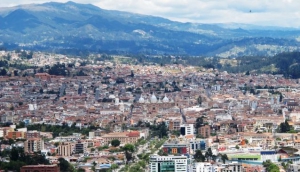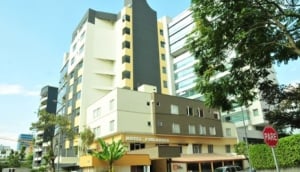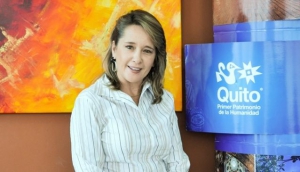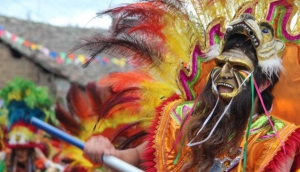Experiencing Ecuador in Otavalo Market
Chirimoyas, guanabanas, naranjillas, babacos and pitahayas are arranged in piles...
Book Top Experiences and Tours in Ecuador:
If youʻre booking your trip to Ecuador last minute, we have you covered. Below are some of the top tours and experiences!- Quito: Middle of the World Tour with Tickets
- Guayaquil: Cloud Forest, Hiking & Canyoning Full Day Tour
- Quito: Night street food, art and drinks
- Historic City of Quito and The Middle of the World
- From Cuenca: Cajas National Park Half-Day Trip
Our red van swiftly heads north on the Pan American Highway, skillfully driven by Diego. We left Quito a little over an hour ago and suddenly, a magnificent view unfolds before our eyes: the beautiful Lake of San Pablo, Ecuador’s largest lake, stretching out at the foothills of the imposing Imbabura Volcano. The scene is fit for a post card. For many European visitors it recalls something of Switzerland; for others it is just unique and incomparable. The lake’s blue waters dominate the scene. The mountain surroundings, dotted with an endless patchwork of terraced fields of maize, potatoes and vegetables, and the quaint little villages nestled around the lake, create an amazing backdrop, a bucolic atmosphere of grandeur, enhanced by the colossal volcano overlooking the whole area. Of course, we stop for pictures at a strategic lookout point on the roadside.
A few minutes later we reach the ancient city of Otavalo, home of the “Otavaleño” indigenous people, descendants of the Caranqui culture, in pre-Incan times. The city is famous for its market, in particular for its woven items. With tourists always wishing to see the market, nowadays it is a daily event. However, traditionally, the (ancient) market only took place on Saturdays. And, today is Saturday, the day of the week when the market is at its very best. Blue skies and an amazingly pleasant, even warm temperature, contrast with the 2,400 metre altitude in the heart of the Andes. My fellow travel companions are an Italian family and two elderly English brothers, all of them look happy and excited.

First we visit the food market, a bizarre mix of the chaotic and the organised. Hundreds of buyers and sellers busily come and go through the narrow maze of cobblestone streets twisting around several blocks. As far as organisation goes, there are specific sections for vegetables, potatoes, meat, poultry, fish, fruit, herbs and every imaginable ingredient. The produce of the land is displayed here in all its richness, variety and, in many cases, uniqueness.
In the fruit section we can see nicely arranged piles (or rather pyramids) of chirimoyas, guanabanas, naranjillas, babacos, pitahayas, maracuyas (passion fruit), tree tomatoes and moras (a local type of blackberry), all exotic fruits of the land, mainly growing in warm subtropical valleys in the Inter Andean region or on the eastern and western flanks of the Andes. They share space with the more than a dozen varieties of plantain and banana (Ecuador is the world’s leading producer and exporter of bananas), mangos, peaches, apples, pears, melons and giant watermelons. The place fills the senses with colours, sounds and smells.
The Otavaleños have always been skilled merchants, but they are also magnificently skilled crafts men and women, mainly dedicated to various types of weavings and woven items. The men wear their impeccable white trousers, white “alpargata” sandals, traditional blue ponchos and felt hats. The women wear their multi-layered “anaco” long skirts, always of a dark blue color, beautifully embroidered white blouses and golden bead necklaces. Trucks and pickups loaded with sacks of potatoes, onions, vegetables and fruit slowly make their way through the crowded streets; the place teems with colour, movement and business.
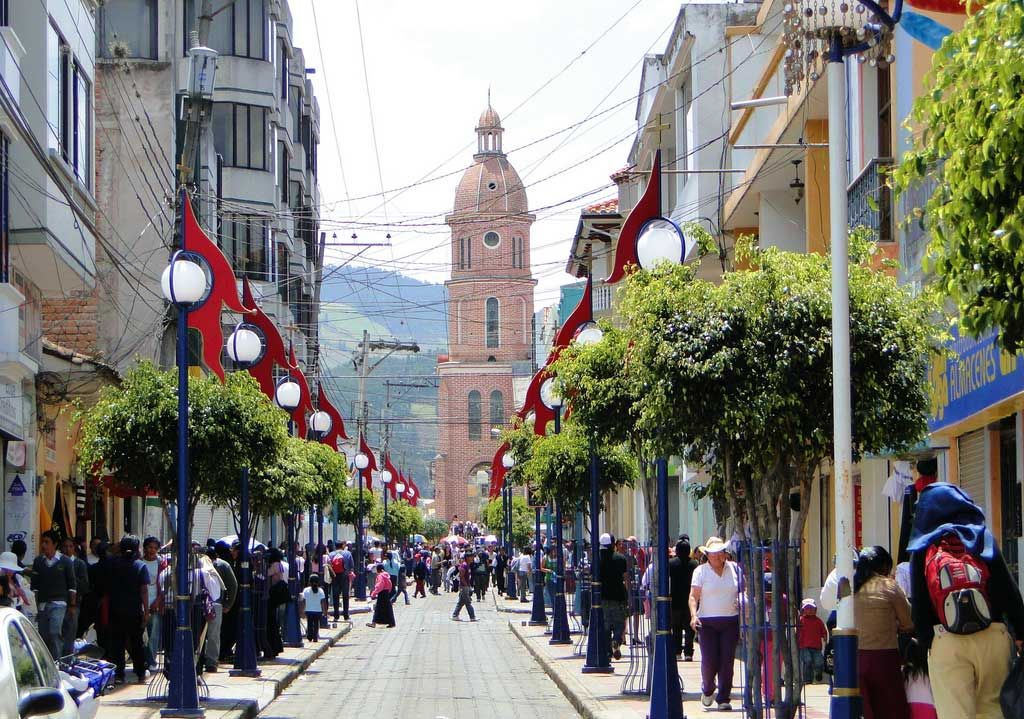
After visiting the food market, we walk through the busy and crowded streets, to the “Square of the Ponchos”. This is a large plaza, housing a multicoloured mosaic of woven products: ponchos, shawls, scarves, sweaters, tapestries, hammocks, table cloths and a large variety of hand woven items, the signature products of the Otavalo area.
The activity is intense along the endless lines of stalls full of merchandise. An impressive feature is the fact that this is a rather silent market, there are no loudspeakers or people shouting announcements; all of the transactions occur in polite silence. That’s not to say that a certain buzz isn’t created by the thousands of people, sellers and buyers, moving around the square, hanging over the crisp Andean air. For a few minutes I stop and try to imagine how this same market would have looked (and sounded) some centuries ago, without the presence of tourists.
Bargaining is part of the fun. Practiced centuries ago, it is still very much part of the market experience and the cheerful Otavaleños seem to enjoy a good haggle with their visitors, while they exchange smiles and, much to my surprise, a few phrases in English, Italian and even French with their guests. All around the square there are also stalls with an amazing variety of handicrafts from all over Ecuador, including “tagua” (the vegetable ivory), figurines, silver jewellery, marble objects, Andean “naïf” paintings from the village of Tigua and much more. This has got to be one of the most complete open air handicrafts markets in South America.
The market, the people, the merchandise - handicrafts and products - together with the relationship with the hospitable indigenous people of the area create a unique and fully enjoyable experience. Plus, it supports the local economy, as most of the visitors leave the scene with bags full of shopping, garments and souvenirs to take home as a memory of Ecuador’s most famous indigenous market, its culture and varied, top quality handicrafts.

Back to the van, with Diego at the wheel, we take a short ride along a narrow cobblestone country road, into the village of Peguche, a small, quanit place where almost every house is a weaving workshop. This is where many of the garments we had seen (and possibly bought) at the Otavalo market are actually woven… it is the “weaver’s capital of Ecuador”. We stop at Esperanza’s house, a cheerful Otavaleño woman in her mid-thirties who gladly leads us inside to show us “live” how the articles are woven, either on rustic wooden looms or on the more traditional and original strap-looms. First she jovially shows us stacks of the raw material: wool, from sheep or alpaca, the two main producers of the material which is tailoured into a garment or ornament piece. Next, she shows us how colour is given to the whitish wools, by using only the seeds of native plants. She gladly agrees to be photographed while she amazes us in demonstrating how the combinations of two or more of such plant seeds can create a new colour, and we rapidly come to understand (and admire) how the finished products have those intense orange and purple colours. Finally, Esperanza sits at one of the wooden looms and gives us a practical demonstration of how to weave. The loom has three pedals and we marvel at her skill and concentration as she synchronizes her feet at full speed, moving amongst the three pedals and her hands cross the weaving material and combine the colours over the loom. Yet another fabulous experience.
We leave the place with the satisfaction of having had direct contact with an amiable people and having experienced their ancestral wisdom and knowledge, sharing a few minutes of cheer and smiles while learning about their ancient and fascinating culture. The long morning is topped off by a delicious lunch featuring delicacies of Ecuador and the Northern Andes. We sit lakeside, two feet away from the magnificent Lake San Pablo at a charming country inn, with the gigantic Imbabura Volcano watching us from across the water. Otavalo and the Imbabura province, just one and a half hours north of the capital city of Quito are, without doubt, a “must” during a visit to Ecuador.
Love Luis’ account of the Otavalo Market? You may find the following useful!
Where to shop in Ecuador
Where to stay in Ecuador
Things to do in Ecuador
